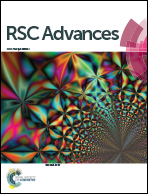Insights into ultrafast charge-pair dynamics in P3HT:PCBM devices under the influence of static electric fields†
Abstract
Polymer-fullerene blends based on poly(3-hexylthiophene-2,5-diyl) (P3HT) and phenyl-C61-butyric-acid methyl ester (PCBM) have been extensively studied as promising bulk heterojunction materials for organic semiconductor devices with improved performance. In these donor–acceptor systems where the bulk morphology plays a crucial role, the generation and subsequent decay mechanisms of photoexcitation species are still not completely understood. In this work, we use femtosecond transient absorption spectroscopy to investigate P3HT:PCBM diodes under the influence of applied static electric fields in comparison to P3HT:PCBM thin films. At the same time, we try to present a detailed overview about work already done on these donor–acceptor systems. The excited state dynamics obtained at 638 nm from P3HT:PCBM thin films are found to be similar to those observed earlier in neat P3HT films, while those obtained in the P3HT:PCBM devices are affected by field-induced exciton dissociation, resulting not only in comparatively slower decay dynamics, but also in bimolecular deactivation processes. External electric fields are expected to enhance charge generation in the investigated P3HT:PCBM devices by dissociating excitons and loosely bound intermediate species like polaron pairs (PPs) and charge transfer (CT) excitons, which can already dissociate only due to the intrinsic fields at the donor–acceptor interfaces. Our results clearly establish the formation of PP-like transient species different from CT excitons in the P3HT:PCBM devices as a result of a field-induced diffusion-controlled exciton dissociation process. We find that the loosely bound transient species formed in this way also are reduced in part via a bimolecular annihilation process resulting in charge loss in typical donor–acceptor P3HT:PCBM bulk heterojunction semiconductor devices, which is a rather interesting finding important for a better understanding of the performance of these devices.



 Please wait while we load your content...
Please wait while we load your content...